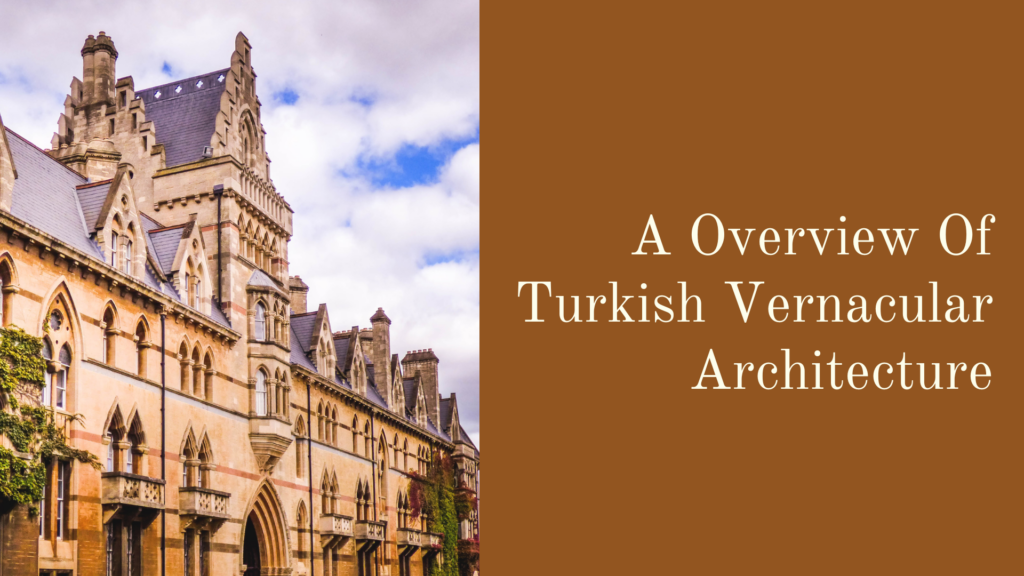A Overview Of Turkish Vernacular Architecture

Turkey, which carries the history of various eras, displays architecture influenced by Byzantine, Ottoman, and Seljuk styles. As a result of international transformations and political and social events, the current architecture of the nation is undergoing change. The architecture of Turkey is the result of several different periods of the nation’s history. Turkey, one of the earliest permanently occupied regions in the globe, is both a barrier and a bridge between Asia and Europe, serving as both. This developing nation possesses a strategic geopolitical position and regional influence. Cultural legacies abound on the area, which has been shaped by millennia of occupation by diverse groups of people. Turkey is currently home to 19 UNESCO world historic monuments and is one of the world’s most visited countries.
Also Read:- An overview of Berlin’s Brutalist Architecture
Even while Turkey is best known for its churches, Medrese, tomb monuments, and dome-topped mosques, the country’s traditional dwelling has an equally rich past. Beginning with simple and primitive dwellings, such as tents, the vernacular architecture of Turkey grew more settled as the nomadic lifestyle transformed with the rise of the empire. The Turkish Neoclassical Architecture Movement reached its pinnacle during the Ottoman era (also known as the First National Architectural Movement). However, from the 1930s, architecture began to shift due to the emergence of foreign architects. During the Second National Architectural Movement (during World War II), architects sought to construct modern yet nationalistic structures.
Turkey is one of the nations with a variety of traditional housing cultures that have evolved with their own distinctive traits. The architecture is distinct from regional characteristics and the surrounding environment. Climate, geographical location, social and urban structure, spatial organisation, and accessible materials influence the form of the housing. The dwellings were designed with the natural landscape and climate in mind. They were intended to reinforce the environment rather than dominate it.
The Ottomans believed in building functional homes without wasting any resources. They considered a huge residence to be pompous. The dwellings they constructed were of straightforward design. All of the house’s components are not only utilitarian, but also have philosophical and symbolic significance.
Planning and layout
In contrast to other countries, Turkish vernacular homes are not arranged on a grid. The roadways were built after the construction of the homes. The dimensions of the streets were decided by the human scale and climate. For instance, the roadways in hot and wet countries are typically narrow and covered. The residences respected each other’s privacy and did not obscure each other’s views, breezes, or sunlight.
The most influential component in determining the architecture of a typical Turkish home is the need for seclusion. The design contains multipurpose rooms, courtyards, and open corridors due to the typical extended family structure of the Turkish people. The ground floor primarily features garden walls or services, while the higher floors have individual or family rooms. The houses are expandable and modifiable to meet the needs of individual families. It is feasible to add extra rooms as the family grows, or to subdivide the existing rooms or the entire house, if necessary.
Typical Turkish home design (derived from Ucar) researchgate
The design of a Turkish home is simple, sustainable, and rationalist, and incorporates numerous modernist ideas. In addition to being utilitarian, they also reflect life philosophy, design, and technology.
The houses have both “open-cool” and “closed-safe” areas. They are designed to accommodate various seasonal needs. An open-cool summer room, for instance, is a place that keeps relatively cool during the summer. It is achieved by orienting the room in a direction where open air flows, by using thinner materials for the walls and flooring, and by installing large windows. A closed-well-protected room, on the other hand, is located between the middle levels and is normally insulated from direct airflow, has thicker and impermeable walls, and relatively smaller windows to give warmth during cold climate conditions.
Utilising local resources strategically, constructors devised sophisticated responses to harsh natural and climatic conditions. The chimney of a Mugla home is an illustration of such assimilation. The residence is located on the eastern Black Sea, a region with the most precipitation. The house’s chimney was constructed to be 180 cm tall in order to withstand the effects of rapidly changing winds and heavy precipitation. The exterior walls were protected by the roof timbers. The structural features, such as doors, windows, stairways, cupboards, etc., were finished using native materials.
As people in Turkey lived in extended families, the rooms of the house played a significant role in the development of the interiors. The standard room names were Sofa, Hayat, and Eyvan. Sofa and Hayat are multifunctional corridors between rooms, whilst Eyvan is a semi-open area between rooms. Generally, the “rooms” are the primary components of a home’s design. Since the rooms are multifunctional, it is thought that the design was inspired by tents (the first living settlement for Turkish people). Typically, they conduct functions such as eating, living, working, sleeping, etc.
The house’s expansion is centred on the rooms. House size is determined by the size of the room. The room sizes are dictated by the available resources. The dwellings can vary in terms of their construction materials, but the room is always the primary element.
Materials and Architecture
The use of space, apertures (doors and windows), and other elements determine the degree of modulation in Turkish vernacular architecture. Due to the use of constrained construction materials, one may see modulation and standardisation in Turkish vernacular houses, however they differ in terms of layouts and details.
Climate and the surrounding environment determine the material’s application. Wood and stone were the most often utilised construction materials, with regional variations in the types of wood and stone. Two forms of housing can be distinguished based on the construction materials utilised in different regions: timber-framed houses and masonry houses.
Timber-framed houses
This is the most distinctive style of traditional Turkish dwelling. The houses are typically two to three floors tall. On the bottom floor, masonry or wooden pillared buildings are utilised, whereas wooden frames are utilised on the upper stories. Local materials such as Adobe, clay, brick, stone, and soil, among others, vary by location for use as filler material. These homes are typically seen in Turkey’s coastal and interior regions.
Masonry buildings:
These homes are typically two to three floors tall. Stone is the principal construction material. Some houses feature beautiful woodwork on their roofs and doorways. Typically, they consist of courtyards, atriums, cloisters, and other similar open and semi-open areas.
The southern east regions/Anatolia region is notable for its usage of ashlar walls and cut-stone wall coverings. The majority of the residences here feature flat roofs and patios.
In the regions of the Aegean and Mediterranean, buildings are constructed with rubble walls and mortar. Typically, they feature flat or hipped roofs. Some of the houses include orioles made of wood.
House typical of the Aegean or Mediterranean property guides
In the eastern areas of Turkey, the majority of the houses have flat roofs and are constructed with rubble walls and mortared wooden beams. The regions surrounding the Taurus Mountains include wooden beams and mortared rubble walls. The construction employs dry-laid brickwork.
The majority of traditional Turkish homes are created to complement the climate, topography, and environment. They are created using sustainable methods and have developed and changed in response to changing cultural, social, and environmental demands.
Harran’s traditional beehive-roofed homes:
In addition to the traditional wood or stone dwellings, Turkey also offers a “Beehive Dome vernacular house.” Typically, they inhabit Harran, a plain southeast Turkish city situated between the Euphrates and Tigris rivers. This particular architectural style is unique to this region of Turkey.
The Harran homes may be constructed as quickly as tents. The major building material is Adobe (burned/sun-dried shallow bricks). The interiors of these homes are renowned for being cool in summer and warm in winter.
Harran’s Beehive Dome house turkish travel blogs
The house’s thick mud walls trap cold air and keep the sun away. They feature few openings to reduce the sun’s glare and the flow of warm and cold air during the day and night. The lofty domes capture the hot air, keeping it away from the ground floor and thereby aiding in the cooling of the interiors. The floors of the dwellings are elevated slightly above the exterior earth.
These homes have been constructed to withstand high winds and moderate earthquake tremors.










